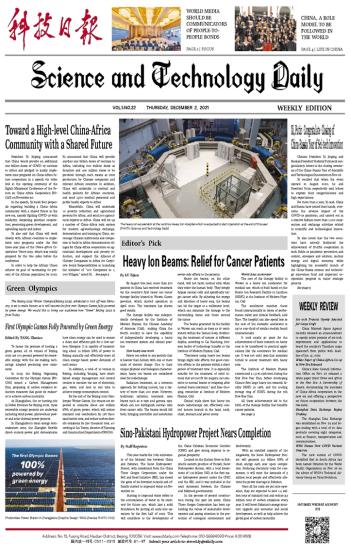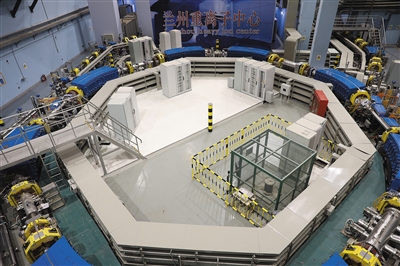
 CHINA, A ROLE MODEL TO BE FOLLOWED IN THE WORLD PAGE 4 | LIFE IN CHINA
CHINA, A ROLE MODEL TO BE FOLLOWED IN THE WORLD PAGE 4 | LIFE IN CHINA World Media Should Be Communicators of People-to-People Bonds
World Media Should Be Communicators of People-to-People Bonds Toward a High-level China-Africa Community with a Shared Future
Toward a High-level China-Africa Community with a Shared Future 无标题
无标题 First Olympic Games Fully Powered by Green Energy
First Olympic Games Fully Powered by Green Energy Heavy Ion Beams: Relief for Cancer Patients
Heavy Ion Beams: Relief for Cancer Patients Sino-Pakistani Hydropower Project Nears Completion
Sino-Pakistani Hydropower Project Nears Completion Xi, Putin Congratulate Closing of China-Russia Year of Sci-tech Innovation
Xi, Putin Congratulate Closing of China-Russia Year of Sci-tech Innovation WEEKLY REVIEW
WEEKLY REVIEW 无标题
无标题 无标题
无标题
 |
| The heavy ion accelerator at the Lanzhou Heavy Ion Hospital which is expected to start operation at the end of this year. (PHOTO: Science and Technology Daily) |
Editor's Pick
By August this year, more than 370 patients in China had received treatment via the country's first heavy ion tumor therapy facility located in Wuwei, Gansu province, which started operation in April 2020. The treatment has shown good results.
The therapy facility was independently developed by the Institute of Modern Physics, the Chinese Academy of Sciences (CAS), making China the fourth country to have the capability of independently developing a heavy ion treatment system and clinical practice.
How heavy ions work
Heavy ion refers to any particle that is heavier than helium with one or more units of electric charge. Due to their unique physical and biological characteristics, heavy ion beams are considered ideal for radiotherapy.
Radiation treatment, as a common approach for battling tumors, has a history of more than 100 years. However, traditional radiation treatment uses beams such as x-rays and gamma rays, which can not distinguish normal cells from cancer cells. The beams would kill both, bringing inevitable and sometimes severe side effects to the patients.
Heavy ion beams, on the other hand, will not harm normal cells when they enter the human body. They simply bypass normal cells and specifically target cancer cells. By adjusting the energy and direction of heavy ions, the beams can hit the target at a millimeter level, which can minimize the damage to the surrounding tissue and those around the tumor.
The beams generated by the facility in Wuwei can reach as deep as 27 centimeters within the human body, facilitating the treatment of tumors at different depths, according to Cai Xiaohong, division leader of technology transfer at the Institute of Modern Physics, CAS.
"Treatment using heavy ion beams brings slight side effects, but good curative effects to the patients within a short period of treatment time. It is especially suitable for the treatment of solid tumors that are not fit for surgery, not sensitive to normal beams or relapsing after normal beam treatment," said Xiao Guoqing, researcher at Institute of Modern Physics, CAS.
Clinical trials show that heavy ion beam radiotherapy can effectively control tumors located in the head, neck, chest, stomach and pelvic cavity.
World class accelerator
The core of the therapy facility in Wuwei is a heavy ion accelerator for medical use, which is built based on the Heavy Ion Research Facility in Lanzhou (HIRFL) at the Institute of Modern Physics, CAS.
The accelerator matches those found internationally in terms of performance index and clinical feedback, said Xiao. The hospital can also spend less as the cost of the domestic accelerator is up to one-third of similar models found internationally.
It took nearly 30 years for the achievements of basic research on heavy ions to be transferred to practical applications like the accelerator for medical use. It was not until 1993 that scientists turned to cancer treatment with heavy ions.
The Institute of Modern Physics constructed a 1.5-m cyclotron during the first Five-Year Plan, before developing China's first large heavy ion research facility HIRFL in 1988, and the cooling storage ring of HIRFL during the 9th Five-Year Plan.
All these achievements led to the birth of the therapy facility that benefits cancer patients.
More therapy facilities under construction
Ma Zhen, chairman of the board of CAS Ion Medical Technology Co., Ltd., said that there are four heavy ion therapy facilities now being constructed and more cooperative agreements signed. Population and geographic factors will be taken into account regarding the construction of such facilities. Their accessibility improves if they are built in the country's regional medical centers.
Much smaller facilities will be developed to benefit more patients and reduce the cost of treatment, said Xiao. Scientists will also upgrade the facilities by adopting technologies like artificial intelligence and 5G.
Personnel specialized in heavy ion treatment, such as frontline doctors and medical physicists, will also be trained, so as to provide more patients with the benefit of heavy ion therapy.

 Next
Next



